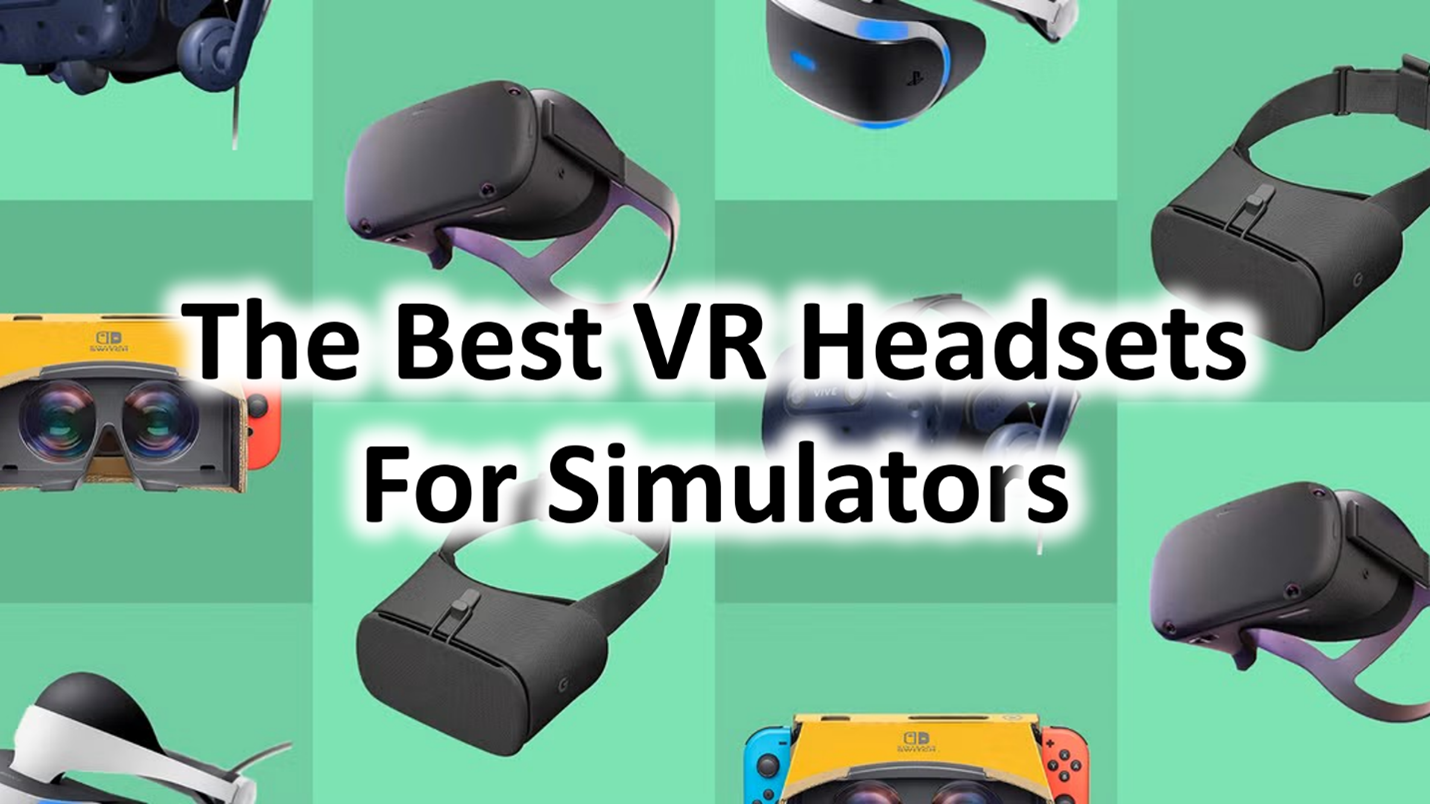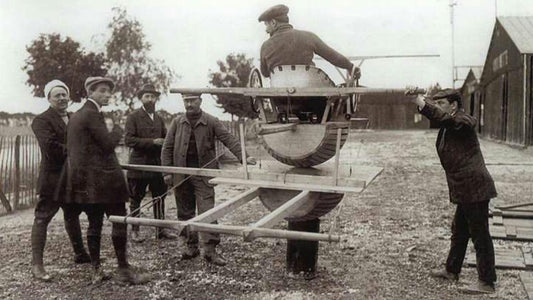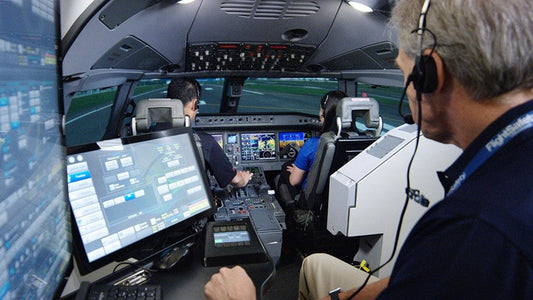The Best VR Headsets for Simulators

VR headsets have a certain magic about them that lets us materialize our very own fantasies albeit in a simulated world. Modern-day virtual reality devices have gotten so better that it's hard to tell the difference between what’s real and what’s virtual.
However, not every VR headset is built for simulators. There are a variety of models available in the market but only a few are good for simulation. So, which ones are the best? That’s exactly what we’re about to find out!
In this article, we’ll take a look at the best VR headsets for simulators. Whether you’re looking forward to racing in your dream sports car or flying on endless horizons, we’ve got you covered!
Pimax Crystal

For years, Pimax has been a reliable brand in the ultra-high resolution realm, and the Pimax Crystal is no exception. Its mini-LED panels offer 2880×2880 per eye, making the clarity truly out of this world. Whether you're racing down that simulation racetrack or flying through an idyllic virtual plane ride, you'll see things as clearly as in real life—granted, not necessarily realism.
One of its biggest advantages is its glass aspheric lenses, which reduce blurriness and improve sharpness across the entire field of view. Where other VR headset makers may skimp on the lenses, Pimax delivers top-tier optical quality. The 140-degree field of view (FoV) ensures realism just as if you're really there in the space. Plus, with refresh rates of up to 120Hz (or higher with overclocking), motion feels incredibly smooth.
However, your GPU is going to be begging for a lot, so expect to need an RTX 4090 (or somewhat equivalent) to get started on this one. Additionally, Pimax software can be somewhat tricky to set up, especially if you’re not used to tech-savvy things and stuff like that.
When it comes to design, the headset is aesthetically pleasing. The internal motion-tracking cameras eliminate the need for external base stations and thus simplify the setup process. However, its 960-gram weight is quite heavy compared to other alternatives out there and may cause slight discomfort during extended use. So keep that in mind before getting your hands on Pimax Crystal, one of the best VR headsets for simulators in 2025 and beyond.
Meta Quest 3

For those on a budget who are new to virtual reality, the Meta Quest 3 is the best VR headset for simulators that you can buy. It offers the best quality, price, and ease-of-use options across the board for novice VR users.
The Snapdragon XR2 Gen 2 Chipset provides everything from improved graphics to quicker processing to an all-around more fluid experience. Quest 3 boasts 2064×2208 resolution per eye (that's over 4K total) with a 110-degree field of view (FoV). The result is an overall sharper experience with more detail across the board. A 120Hz refresh rate makes movement even more fluid, resulting in less nausea and greater engagement.
At 515 grams, the worries about extended wearing time should not be a factor. One of its biggest strengths is its standalone capability, meaning you can jump straight into VR without needing a high-end gaming PC. Quest 3 also supports PC VR connectivity via Air Link as well as a wired connection. So either way, getting started is a walk in the park.
However, there is a manual IPD adjustment instead of a motorized IPD adjustment like other headsets possess. Since it is less precise than motorized options, it may lead to slight discomfort for some users. While the headset supports hand tracking, it lacks eye-tracking features found in higher-end models, which could limit certain interactive experiences.
Meta Quest Pro

The Meta Quest Pro is our recommendation for the best mid-range VR headset for simulators in 2025. It has the most effective performance for the price. Among many things, it boasts excellent clarity, decent comfort, decent tracking, and a host of high-end features without the price of ultra high-end VR.
Perhaps the most innovative aspect is the pancake lens, which keeps everything in focus throughout the field of view (FoV). Unlike many headsets of yore that only featured a focused center screen—with everything along the edges blurred and distorted—the Quest Pro keeps everything on screen in focus wherever it may be situated, making it easier to read a dial in a plane's cockpit or a racing simulator and rendering street signs and small print legible. In addition, the expanded field of view (about 106 degrees horizontal) places the user further into the experience. Moreover, there's a QLED display that prevents the LCD washout from many headsets with brighter colors and clearer contrast.
Comfort is subjective, but the balanced design with a rear-mounted battery helps distribute weight more evenly. However, some users find the forehead padding less comfortable during long sessions. While battery life is decent, it's lower than the majority of all-in-ones and has users plugging it in every now and then.
Despite these minor drawbacks, the Meta Quest Pro remains a fantastic choice for serious sim enthusiasts, offering a premium experience at a mid-range price.
Pimax 8K X

For those who want the absolute best VR headset for simulators, the Pimax 8K X is in a league of its own. The resolution is true 8K with a combined 3840×2160 per eye, so all cockpit instruments along with road signs/details and peripheral scenery are in focus all of the time. But the best part about this headset is the ultra-wide 200-degree field of view (in comparison, the average consumer headset has a 100 FoV). This means you can see more of your surroundings, creating a near-life-like experience that no other headset can match.
Pimax 8K X features dual CLPL LCD displays with an upscaling mode of 90Hz and 120/144Hz refresh rates for clear visuals and uninterrupted motion. It has a detachable audio strap, and the comfort level is further raised with lighthouse tracking compatibility for precise movement detection.
In terms of comfort, the Pimax 8K X is relatively light. It weighs around 450 grams, so it's not overly heavy and is comfortable for extended periods of wear. It also has an adjustable IPD of 55–75 mm.
But nothing comes free. The Pimax 8K X requires a minimum beast GPU to run (RTX 4090, RTX 3090 at least as a minimum), and even with that, it seems word on the forums is that one has to adjust supersampling settings for optimal performance which is frustrating. Additionally, setup can be complex, especially for newcomers to Pimax devices.
HP Reverb G2

For the best budget VR headset for simulators, we turn to the HP Reverb G2. From a lightweight experience to simple installation to excellent graphics, the G2 has seemingly everything. The 2160×2160 per eye default resolution (that's over 4K combined) allows for clarity on the screen while in simulation to read highly complex gauges, dashboards, and scenery more effectively.
There are various advantages to going with the Reverb G2 headset. For example, one of its key advantages is its inside-out tracking, which requires no external base stations—just plug it in and start playing. Therefore, it's very accessible for the novice user. With motion controllers, you can interact with everything in VR. In addition, it weighs under 500 grams which makes it one of the lightest VR headsets on the market. It's not painful for the neck or head to wear this for extended use. The field of view (FoV) is 98 degrees for decent immersion. Although it is slightly lower than the more expensive headsets, but still applicable for the price.
However, it's important to note that the manual interpupillary distance (IPD) adjustment, which ranges from 60mm to 68mm, may not offer the precision of motorized systems, potentially affecting visual comfort for some users.
Furthermore, there are four cameras for tracking which, though effective, falls short when compared with other alternatives that boast six cameras. As such, this might result in less accurate eye tracking in certain scenarios.
Varjo Aero

The Varjo Aero is undoubtedly one of the best VR headsets for simulators that offer exceptional features for sim enthusiasts. Each eye benefits from a high-resolution display of 2880×2720 pixels, providing over 4K resolution per eye. This clarity ensures that users can see fine details such as small text with high precision in their virtual environments.
The Aero has a field of view of over 120 degrees, increasing the simulated depth of reality, and it has automatic interpupillary distance (IPD), utilizing its eye-tracking feature to calibrate the most effective distance between lenses for each user naturally.
Latency of movement detection is nonexistent with Aero tracking at 1000Hz. That frequency is so high that latency is decreased, allowing the virtual world to almost instantly react to user movement.
However, the Varjo Aero requires a powerful gaming PC to run it. It requires this much processing power to create such high-quality imaging and simulation. Also, there's no audio; the device lacks speakers for sound or audio features.
Valve Index

When it comes to simulator games, there's no more immersive option for the best VR headset for simulators than the Valve Index. Whether you're flying, driving, or just walking around various worlds, the Valve Index gives you smooth motion, precise tracking, and excellent visuals to make the experience extremely realistic.
The greatest benefit of this device is the 144 Hz refresh rate. This reduces motion sickness and improves realism, especially during fast-paced simulations. What’s good to know is that the headset supports multiple refresh rates, including 80Hz, 90Hz, 120Hz, and the “experimental” 144Hz mode which we just talked about.
With an adjustable field of view up to 130 degrees, the Valve Index offers a wide visual perspective for an enhanced sense of immersion. It offers physical IPD as well as eye relief adjustments, allowing users to customize the fit for comfort and optimal viewing.
For tracking, the Valve Index utilizes external base stations. The full finger-tracking controllers allow you to grab levers, press buttons, and interact naturally, which is a big advantage for simulators that support hand input.
However, the headset weighs in at 809 grams, so some discomfort from extended wear is inevitable, and it may be more complicated to set up depending on external base stations than headsets with internal tracking.





